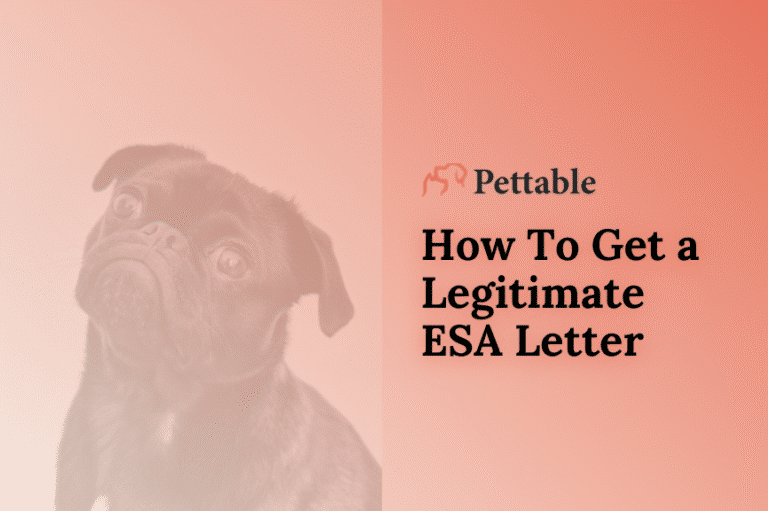How Do You Qualify For An Emotional Support Animal?

An emotional support animal, ESA, is different from a service animal or therapy animal. An emotional support animal is a companion animal that offers stress relief, comfort, and a calming presence to its owner. Usually, an emotional support animal, or ESA, helps its owner cope with mental health conditions day-to-day. There are many types of support dogs, and it can be difficult to know which dog does which job and who they specifically help. There are many reasons why a person may qualify for an assistance animal, but it can be hard to tell what type of support animal a person may need.
See if you qualify for an emotional support animal today.
Difference Between Support Animals
A support animal is one that helps a person each day in a specific way. There are many types of support animals or working dogs, so it can be confusing to know which type of support animal a person might need.
Service Dogs
There are several types of service dogs, and each one helps people in a specific way. Service dogs are specially trained to help individuals perform tasks more independently. Guide dogs, hearing dogs, medical alert dogs, and mobile dogs are all types of service dogs. Guide dogs assist people who are visually impaired. Hearing dogs help people who are hard of hearing. Medical alert dogs warn their owners right before the onset of a medical issue, like low blood sugar or diabetes. Mobile dogs assist individuals with balance issues or those who use walking devices.
Therapy dogs
Therapy dogs are also specially trained, though a therapy dog’s job differs from a service dog’s job. A service dog works each day to ensure that its owner lives safely and independently despite any physical conditions they may have. A therapy dog is a little different. A therapy dog is also a well-trained pet but, instead of helping one person each day, a therapy dog provides affection and comfort to people in hospitals, retirement homes, and similar settings. An emotional support animal differs slightly from therapy dogs and each type of service dog.
Emotional Support Animals
An emotional support animal should also be a well-behaved pet to avoid causing any stress to its owners’ life, but emotional support pets do not need to be specially trained. An emotional support animal does not have to be a dog, though dogs may be the most popular choice for service animals and assistance animals. An emotional support pet, like a service dog, helps one specific person instead of traveling to many different places to help many people like a therapy dog. An emotional support animal offers comfort and companionship to its owner who could suffer from a number of mental health struggles.

Medical Reasons to Have an Emotional Support Pet
There are many reasons why a person may benefit from having an emotional support animal. Emotional support animals are no substitute for a recommendation from a licensed mental health professional to stay safe and healthy. An emotional support animal can help a person alongside treatments and recommendations from a mental health professional. An emotional support pet can offer comfort, affection, and a calming presence to its owner who may suffer from a variety of mental health struggles. Here are a few of the most common reasons that someone may have an emotional support pet.
Anxiety
People who experience anxiety may feel an overwhelming sense of unexplainable fear or worry. Anxiety can cause severe dread and worry, but it also causes physical symptoms. Someone with anxiety may experience sudden unexplained sweat and a rapid heartbeat. An emotional support pet can be a calming presence to anyone suffering from anxiety. When a person with anxiety pets their emotional support animal, it can release feel-good hormones that can be calming.
Depression
Depression is a common but serious medical condition. Someone with depression can experience prolonged feelings of sadness, a loss of interest in favorite activities, a loss of appetite, and many other symptoms. Someone with depression may also have difficulty concentrating, and they may have thoughts of death. While an emotional support animal is no substitute for a doctor’s medical treatments, an emotional support pet can offer comfort, familiarity, and love to its owner suffering from depression.
Chronic Stress
Someone who suffers from chronic stress experiences intense stress and worry for an extended period. Family complications, work issues, or a traumatic event can cause chronic stress. When a person experiences chronic stress, they may notice negative effects on their digestive system, rapid heartbeat, higher blood pressure, and other negative effects on the heart. An emotional support pet allows a person suffering from chronic stress to feel comfort, support, and feel-good hormones.
ADHD
When a person has ADHD, they may have difficulty focusing on tasks or sitting for extended periods of time. Someone with ADHD could benefit from having an emotional support pet because a pet gives structure to a person’s routine. A pet can give someone with ADHD a chance to have frequent breaks to get up and move around with their pet. This can help improve a person’s focus and attention to tasks. An emotional support pet can offer consistency to its owner’s life that can help with this condition.
Panic Attacks
Someone who experiences panic attacks experiences the sudden onset of unreasonable feelings of anxiety, fear, and worry. Someone experiencing a panic attack will likely have many physical symptoms as well. A person having a panic attack might have a rapid heartbeat, increased sweating, and fast breathing. An emotional support pet can help calm someone struggling with panic attacks by offering comfort and love.
Whatever emotional or mental disability a person experiences, an emotional support pet can help a person feel calm and comforted. Mental health professionals may recommend other treatments in combination with the presence of an emotional support pet to help a person cope with their mental health struggles. The process to make a pet an emotional support animal is very simple and straightforward.

How-To Process to Qualify For An Emotional Support Animal
It can be hard to tell if a person would benefit from the support of an emotional support animal. A person doesn’t need to find a dog specially trained, and can instead make a pet they already have an emotional support pet. As stated above, many medical conditions could be helped by the presence of a support animal, but only a medical professional can determine if an ESA is a medical need for someone.
Talk to a Medical Professional
The first step, after acknowledging a medical need for a support animal, is to talk to a licensed medical professional or licensed therapist. Licensed mental health professionals are equipped to offer personalized treatment and solutions to the mental health struggles they experience. Many ESA letter providers will allow people to speak with licensed doctors by video call or phone call.
It’s best to find a company that can help with each step of the process instead of using different services to help. If a doctor determines a medical need for an emotional support pet, they will give you an official letter stating your medical need. A mental health professional can issue letters for emotional support dogs, cats, and other animals that offer emotional support for someone suffering from a mental disability, mental illness, or emotional disability.
Get a Letter
After discussing their concerns with a medical professional, a person may then get an official ESA letter from their doctor. This letter will need to be on the doctor’s official letterhead with the doctor’s information on it, as well as the doctor’s signature. This letter will state that an emotional support animal is a medical need for someone struggling with a mental health condition.
This letter can then be used to share this medical need with landlords, airlines, or restaurants. Landlords must recognize this letter as an official declaration of a person’s medical need for their pet, while restaurants and airlines may not. A landlord must recognize an official ESA letter and waive pet fees as a part of the Fair Housing Act. While emotional support animal laws are always changing, it’s always a good idea to have your emotional support animal letter on hand in case someone, like your landlord, asks to review it.
Whether a person has an emotional support dog, an emotional support cat, or any other type of emotional support animal, these emotional assistance animals offer real support to their owners. A legitimate emotional support animal is one that helps a person cope with daily life occurrences with a mental or emotional disability or major life activities. While emotional disabilities can make a person feel helpless at times, service animals, service dogs, and emotional support animals can help.
There’s a lot of conflicting information about how to qualify for an emotional support animal or ESA. Here’s everything you need to know about the process.
Who Can I Talk To About Getting an ESA?
Anyone with an invisible or emotional disability can approach a medical professional about acquiring an Emotional Support Animal or ESA.
However, you must know which medical professional can help you qualify. It’s not enough to approach a family neurologist or dietitian to write your ESA letter.
You need a physician with expertise in mental health. There are several options here. If you feel you qualify for an ESA, you can talk with a:
- Psychologist
- Psychiatrist
- Therapist
When applying for an ESA, it’s important to remember that your licensed medical health professional must disclose the disability that makes you eligible. Disabilities can feel personal, and not everyone is comfortable with this. But it is a crucial step when making your case for access to an emotional support animal.
What Does My ESA Letter Need to Say?
A letter asserting your right to an ESA needs to meet several requirements. The letter must verify your right to an ESA, contain your mental health professional’s letterhead, and describe your disability while demonstrating that it falls within the bracket of emotional disabilities with a right to a support animal.
Furthermore, it needs to show that without an emotional support animal, you will be unable to participate in certain activities because of your disability.
In particular, the letter needs to stress that the emotional support animal enables you to perform what the medical community calls ‘Life’s major activities.’ The definition of these activities is broad and encompasses, among other things:
- Seeing
- Breathing
- Working
- Studying
In addition to establishing that an ESA enables you to successfully take part in life’s major activities, it needs to clearly state that the presence of the ESA is integral to your ongoing treatment.
Finally, the letter needs to be signed and dated. You cannot use this letter if the date on it is more than a year old. To continue living with an ESA, you need to have the letter regularly reissued by the health professional of your choice.
What Kinds of Animals Qualify as ESAs?
We’re used to service dogs, and increasingly, miniature horses are becoming a popular choice of guide animal. But what kind of animal qualifies as an ESA?
The rule of thumb is that most domestic animals qualify as ESAs. That means dogs and cats, but can also include:
- Hedgehogs
- Mice
- Rabbits
- Birds
- Rats
That said, this may vary from state to state. If you have a pre-existing animal in mind as an emotional support animal, ensure you find out from your health professional if it qualifies when you begin the application process.
Do ESAs Have Legal Protection According to the ADA?
The rules surrounding ESAs have evolved since the ADA first appeared in the 1990s. Briefly, there was a window where all kinds of animals made acceptable ESAs.
However, this proved untenable, especially for landlords trying to simultaneously follow the ADA and observe housing regulations. So, while these days you can’t have an emotional support goat, you still have many options.
That said, even after you qualify for an ESA, they don’t have the same kind of liberties as service dogs. Landlords have to accommodate ESAs according to the American Disabilities Act. But accepting an ESA in a public place is often at the discretion of the business owner.
That’s because ESAs lack the legal protection of well-established guide dogs. Combined with conflicting laws on things like public health, you may find you have a hard time taking a parrot to a restaurant.
Do Qualified ESAs Need Harnesses?
Unlike service animals, ESAs do not need an identifying harness. That is due to the variety of ESAs people can have. It’s challenging to get a hedgehog into a vest, to say the least.
But it also makes it difficult for businesses to distinguish between exotic pets and ESAs. For that reason, if you need to bring an ESA somewhere atypical, like the grocery store, you must have the relevant documentation on you proving that your ESA is more than a pet and it is essential to get your ESA training if you do not purchase an already-trained ESA.
What if I Register My ESA?
It’s possible to register an ESA online, but that won’t give them more legal protection than they would have if you didn’t.
You can indeed get certificates registering your pet as an ESA, but they have as much meaning as the microchip notice you get from the vet. They confirm the registration but don’t mean anything legally. Your safest bet is to get a mental health professional on your side to help you get the most out of the process.






